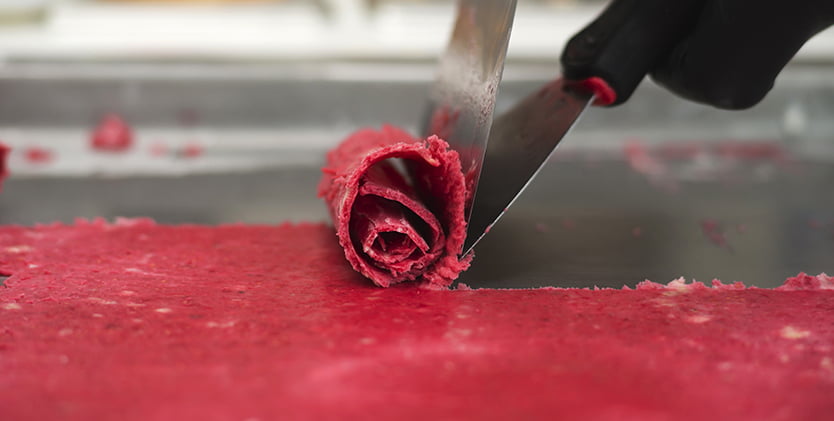
July is designated ice cream month, a ritual started in the USA (where else?) in 1994 by President Reagan and quickly adopted by the International Ice Cream Association (yes, there really is such an Organisation)
To be honest, we don’t care who started it, we just love ice cream. And it seems we are not alone. Last year, we spent almost £1b on ice cream (that’s about 9 litres per person) in the UK alone, placing us fifth in the world. China, on the other hand, leads the field with sales of over $11b- or around one third of total global consumption.
They obviously know a thing or two about ice cream. This is not surprising as they were eating ‘ice cream’ made from milk and rice as long ago as 200BC. To be honest, we’re not that bothered who invented it, just pleased they did.
Today, we probably assume that Italy has a major role to play in the development of modern day ice cream and we’d be right. The Neapolitans are usually credited with innovating the ice cream process. They did this by adding more milk than cream, making it lighter on fat, compared to American style ice cream that contains more cream and thus more fat (around 10%)
It was, however, the USA that gave us affordable ice cream thanks to Baltimore farmer, Jacob Fussell. He established the first world’s first ice cream factory. As a solution to surplus cream and thanks to mass production, ice cream as we know it today was born.
We also have to thank America for putting the razzmatazz into ice cream with the introduction of the ‘Good Humor’(sic) ice cream on a stick and the original ice cream van (truck) complete with ‘calling bells’ (chimes)
It was in 1920’s Ohio, that confectioner Harry Burt created his ice cream on a stick as well as introducing branded ice cream vans. Of course, there’s nothing new about making it easy to eat ice cream. The edible cone (named ‘cornet’) has been around since 1888 and hand carts and trikes have been plying their trade on our streets from the mid 1800’s.
What the ‘good humor’ truck (named after research that proves that eating ice cream actually makes you feel good) did, was pave the way for brand consistency. It was so successful that they were eventually bought out by Walls.
Ice cream now comes in a variety of guises. In the USA, Mr. Softee was launched in 1956 and by 1959 had opened in the UK in partnership with Lyons. Not to be outdone, Walls, who had a long tradition of selling ‘hard ice cream’ from their ‘stop me and buy one’ trikes soon realised the potential of soft ice cream and launched ‘Mr. Whippy’ in a bid to compete.
Ice cream is undoubtedly the ultimate ‘feel good’ treat (try eating one without smiling) It’s been a staple part of our lives for centuries and continues to evolve. Today, you can choose from a huge selection of flavours. These include everything from savoury smoked bacon, chili and even black pudding to the more traditional ones. However, Vanilla is still the nation’s favourite.
You can have it with a chocolate flake (a so called ‘99’ although no one knows why – not even Cadbury’s who own the trademark) and buy it on a Sunday, which is how ‘ice cream sundaes’ came about. In the 19th Century, the US town of Evanston made it illegal to sell ice cream flavoured with soda on the holy day. To get around this, retailers created an ‘ice cream sundae’ with a changed spelling so as not to cross the Church leaders.
Ice cream has certainly come a long way since those ‘stop me and buy one’ days. In the USA alone, ice cream contributes over $39b to the national economy, which is why you can understand President Reagan’s desire to celebrate it.
It’s the same in the UK. It seems we can’t get enough of it. Gone are the days when it was simply choosing between hard and soft ice cream or different flavours, we now actively search out and share the ‘ice cream experience’. Ice cream parlours are springing up all over town offering a wide variety of flavours to suit every taste bud and for that extra special experience ‘Thai inspired ‘rolled ice cream’ has certainly captured the consumer’s imagination.
Presenting ice cream in an almost theatrical setting has to be the product’s ultimate accolade. We’ve seen how it draws the crowds in Asia and throughout the USA and now we’ve brought the teppanyaki ice cream table to the UK market.
Using our teppanyaki plate, catering outlets can create rolled ice cream using fresh ingredients, live in front of their guests. This is the perfect addition to any restaurant, café, hotel and outdoor caterers looking to entice their audience in a new and exciting way.
Success is achieved from a plate that can be temperature controlled between ambient and -30°c), interesting fillings such as fresh fruit, chocolate and biscuits as well as the showmanship of the ice cream ‘sommelier’.
It’s also easy to create handmade ice cream. Chef simply pours liquid ice cream mix on to the cold plate, mixes in the ingredients (such as fresh fruit or chocolate chips etc) and then using a pair of ‘scrapers’ simply flattens it and rolls it into curls ready for serving in cups, cones or waffles
As far as ice cream is concerned, nothing has really changed. Except, that is, for the way it’s presented. Introducing ice cream theatre.
It’s time to discover. Watch our demonstration video